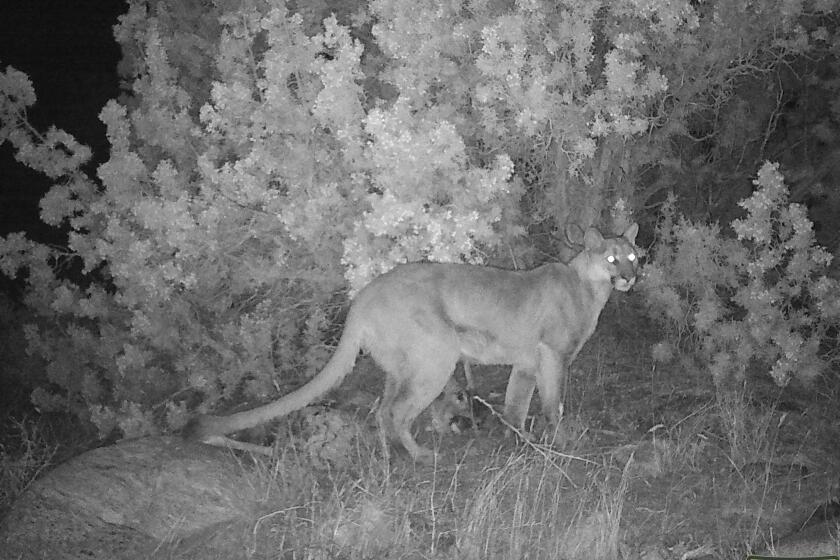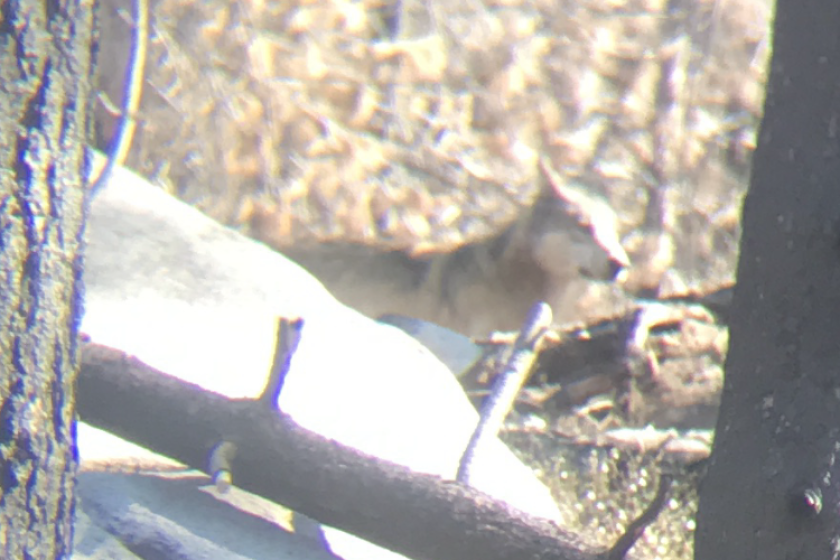‘Round them up and castrate the boys’; California conservationists take aim at wild burros
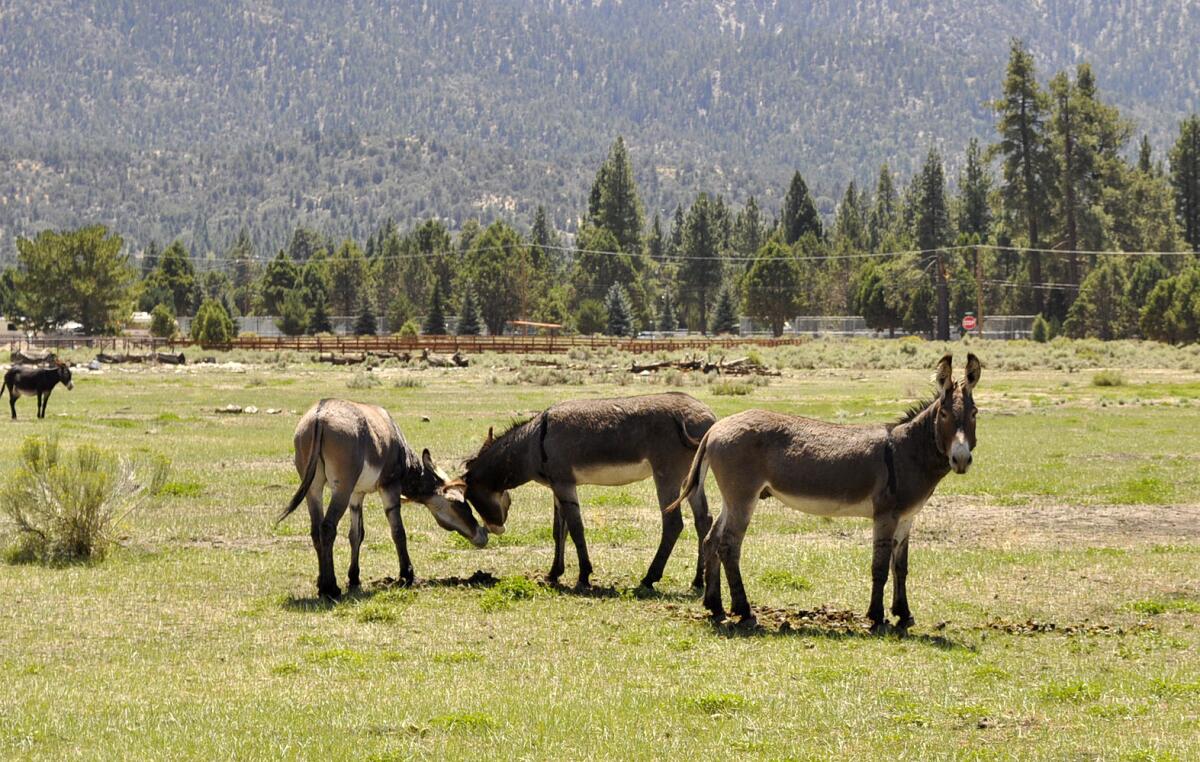
- Share via
BALDWIN LAKE, Calif. — On trash day, they pillage residential garbage bins with the nonchalance of cruise ship passengers at a buffet.
Along environmentally sensitive ponds and creeks, they gnaw vegetation to its root and pile manure along the shoreline.
And at night, they wander onto darkened highways, paying little heed to oncoming traffic.
For San Bernardino Mountains conservationists, the signs are all too clear: Big Bear Valley has a big ass problem.
“We have too many burros — more than we can manage,” said Julie Donnell, a regional wildlife biologist with the U.S. Forest Service.
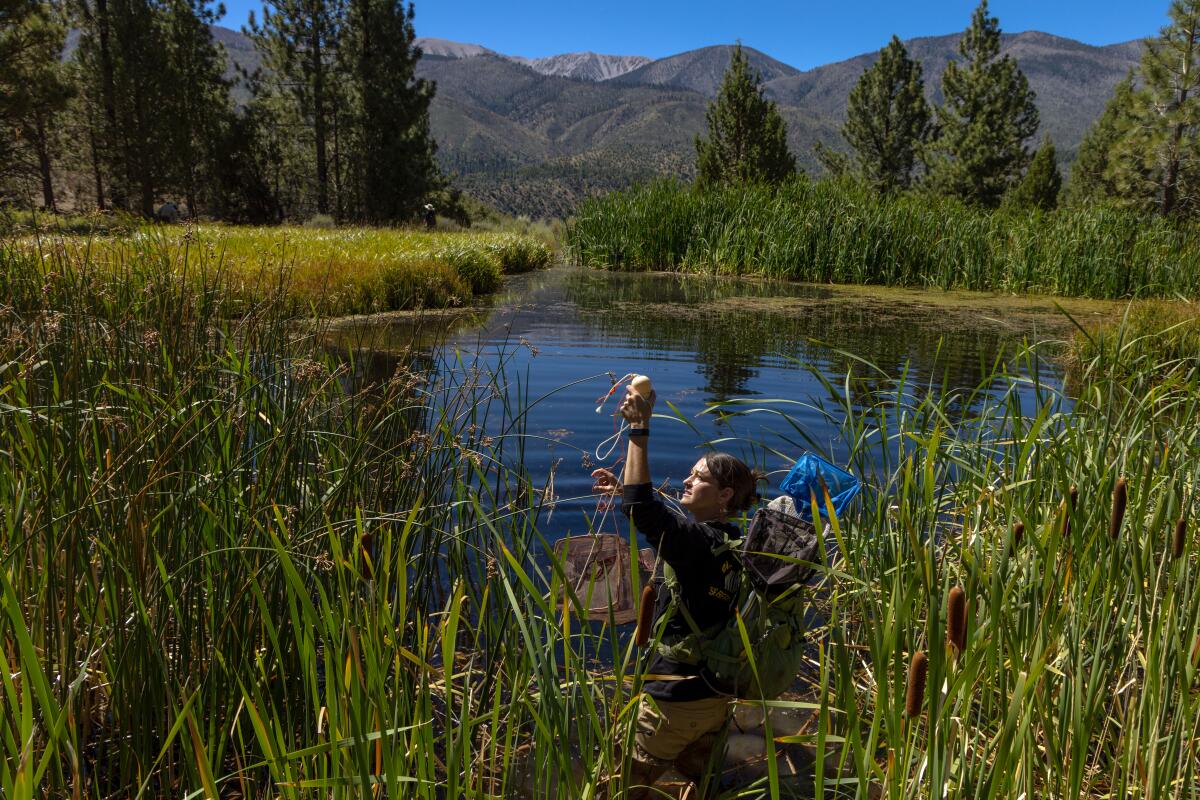
Wild burros, or asses have roamed the sagebrush fields and pine forests of this resort community for generations, and are directly descended from the domesticated donkeys that gold miners left behind more than a century ago.
While homeowners and vacation rental managers have come to adore the furry equines as living symbols of Big Bear Valley’s rustic mountain heritage — as well as an attraction for eco-tourists who reward their heehaws with carrots — some biologists worry that their numbers have reached critical mass.
After two mountain lions who were transplanted to the Mojave Desert died of starvation, California wildlife officials have revised their relocation policy.
With more than a hundred burros roaming the area, conservationists say the animals are starting to overwhelm struggling native species, as well as create a public safety threat for humans.
The time is ripe, they say, to severely reduce the burro population with a roundup that is certain to be controversial.
“I believe authorities should round them up and castrate the boys,” said Julie Moreau, founder of Grateful Heart Animal Sanctuary in eastern Big Bear Valley.
Aggressive and impactful reporting on climate change, the environment, health and science.
“They shouldn’t wait until there are so many burros that vehicles are crashing into them,” she said.
The image of the burro as a miner’s faithful beast of burden contrasts starkly with ecological reality, experts say. The animals breed prolifically, devour all manner of plants, distribute copious amounts of dung around waterways and associate people and cars with food.
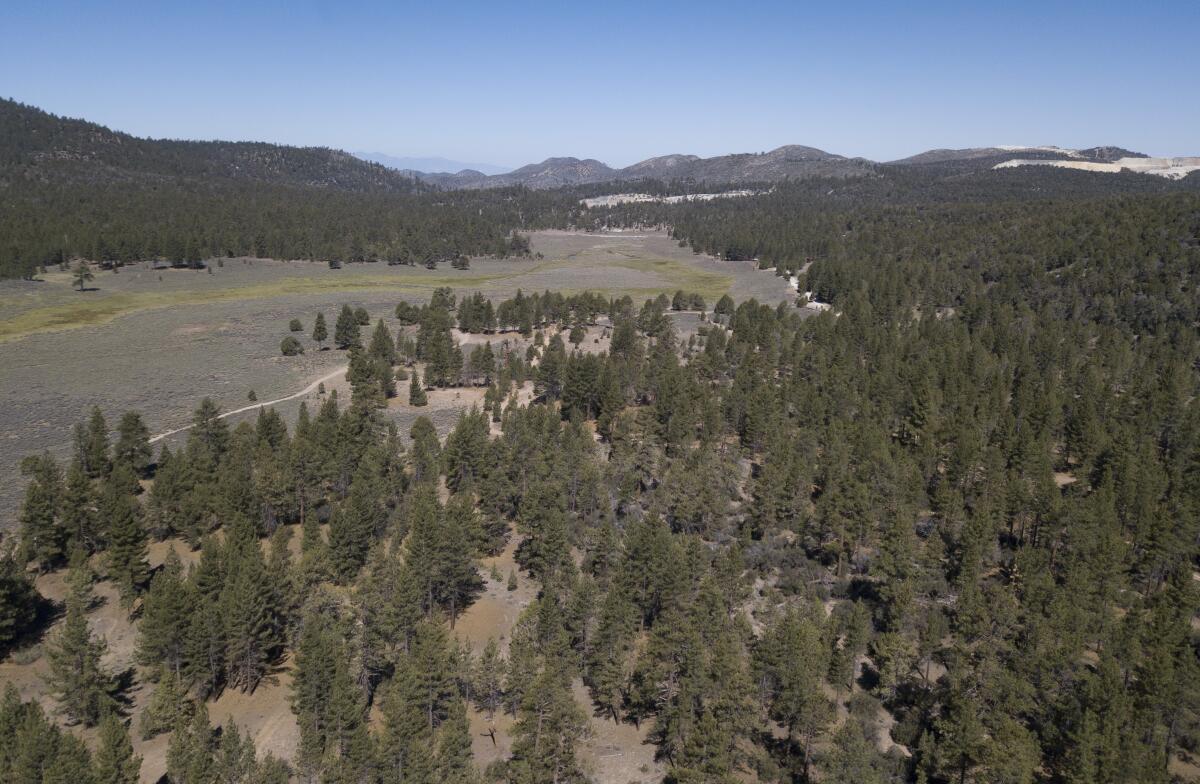
In Big Bear Valley, burros pose the greatest threat to such rare and endangered species as Big Bear checkerbloom flowers, slender-petaled mustard plants, and the unarmored threespine stickleback fish. While not exactly charismatic — or even well known outside a community of biologists — the species are found only in the Big Bear Valley area, or other parts of the San Bernardino Mountains.
Burro roundups have occurred here in the past, most recently in 1997 and 2007, but they have always left a few stragglers who proceeded to multiply. The burro control campaigns have also sparked anger and resentment among residents, who view the animals as part of local history, and not an invasive threat.
The sudden appearance of the so-called Tulare Pack in Giant Sequoia National Monument comes with a number of complications, including concerns for livestock.
For this reason, as well as lack of resources, proponents of a new burro roundup are pessimistic.
“We lack the funding needed to deal with the exploding burro population,” Donnell said. “Will there be a remedy anytime soon? Absolutely not.”
To the casual visitor, there are few signs of a problem. However, anecdotal reports of burros gnawing the latex paint off wood house trim, sauntering into neighborhoods on trash pickup days to sample the smorgasbord of urban discards, and wandering out into local highways to fight over territory and harems have increased in recent months.
The burros stand about 4 feet tall at the shoulders and weigh about 450 pounds. Despite their pot bellies they are fast runners. They mature at about 4 years and have a life expectancy of more than 25 years.
They run in bands of up to 30 with a male in charge. In battles over females, males bite each other on the ears, necks, and legs, then whirl their adversaries in a circle.
State Route 38, one of the three main roads to Big Bear Lake, has become an impromptu outdoor theater. Last Friday, Kathy Bartlett, former editor of a local weekly newspaper, said she had to slam on the brakes to avoid colliding with “two male burros fighting in the middle of the road.”
“They were rearing up on their hind legs,” she recalled, “as a half-dozen females calmly watched from the sidelines.”
For years, vacation rental operations have advised their customers that the burros are wild animals, and that it was best to admire them from a distance.
Michael Dolan, a local Realtor, recalled a 2006 incident in which a friend driving a brand new Lexus suffered a neck injury after colliding with a burro on State Route 38 after dark. A week later, while driving a replacement Lexus provided by her insurance company, she collided with another burro along the same stretch of road.
“She was OK, but the donkey had to be put down,” he said.
Nine years after President Obama created the San Gabriel Mountains National Monument, park officials struggle to cope with hordes of visitors.
Moreau, of the animal sanctuary, said it’s stories like this that make her feel action needs to be taken, though she has great empathy for the animals. “I’m passionate about burros; they are my spirit animals,” she said.
While she doesn’t have a state permit to take in wild animals including burros, she said she always leaves some water and hay out for a trio she described as “a beat-up warrior and his little band of mavens — one of which, I’ll bet you, is going to be pregnant real soon.”
The environmental impacts of the growing burro population are most apparent in the vicinity of spring-fed ponds and creeks in the Baldwin Lake Watershed, which is home to the stickleback and species of plants that are found nowhere else.
Scientists say that burros wallow, graze and trample north Baldwin Lake’s complex of 12 sensitive pebble plains: flat expanses of quartzite pebbles created by receding glaciers that support rare butterflies and 17 protected plant species, most of them miniature in stature.
The federally endangered Bear Valley sandwort, Ash-gray Indian paintbrush, and southern mountain wild-buckwheat are no match for the cascading impacts of soil disturbances caused by burros on the move.
Scientists say their activities alter soil composition and increase erosion, which allows weeds to colonize and multiply, robbing low-lying pebble plain species of water and sunlight.
Baldwin Lake is also an area that contains some of the only affordable undeveloped land left in the Big Bear Lake area, the western half of which is a congested resort community serving the 10 million people who live within a two-hour drive.
In response, conservationists have bought property and, in some cases, blocked development in an effort to preserve what remains of an ecosystem born of glaciers retreating from the 20-mile-long Big Bear Valley more than 15,000 years ago.
The U.S. Bureau of Land Management is considering a move to declare rock collecting a form of mining, and Southern California rockhounds are not happy.
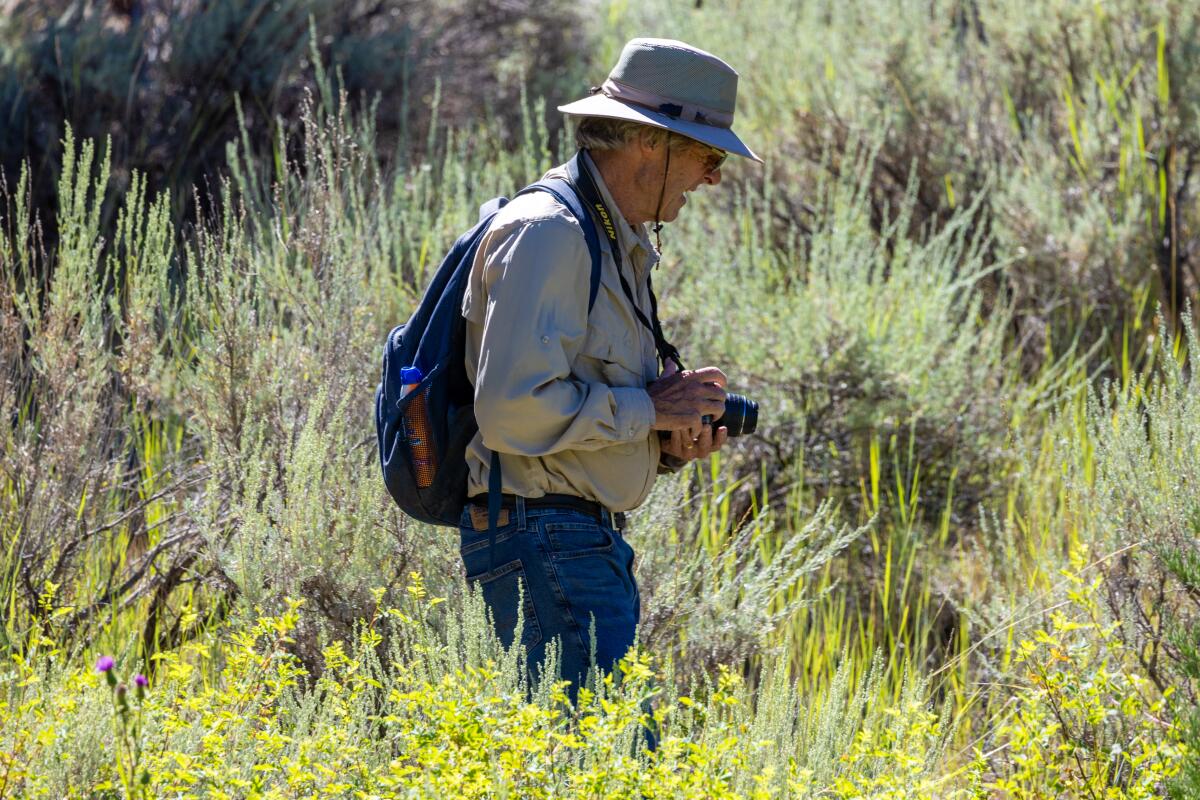
A recent visit to a pond at Shay Creek meadows “revealed extensive damage caused by the burros,” said Tim Krantz, a retired biology professor and former San Bernardino County planning commissioner.
“At least 35 of them had cleared the once lush green meadow vegetation down to dirt. Piles of burro dung ringed the shore, spurring growth of a thick layer of algae,” he said.
The whole area, he said, reeked like a septic pool.
As a condition of a special use permit to collect water for municipal purposes, Big Bear City Community Services District is contractually obligated to maintain barbed wire fences and water flows at Shay Creek, where the stickleback were discovered in 1981. They have done little to deter burros, however.
Under such circumstances, Krantz and others have reasoned that if the burros cannot be removed, the stickleback have to be relocated for their own safety.
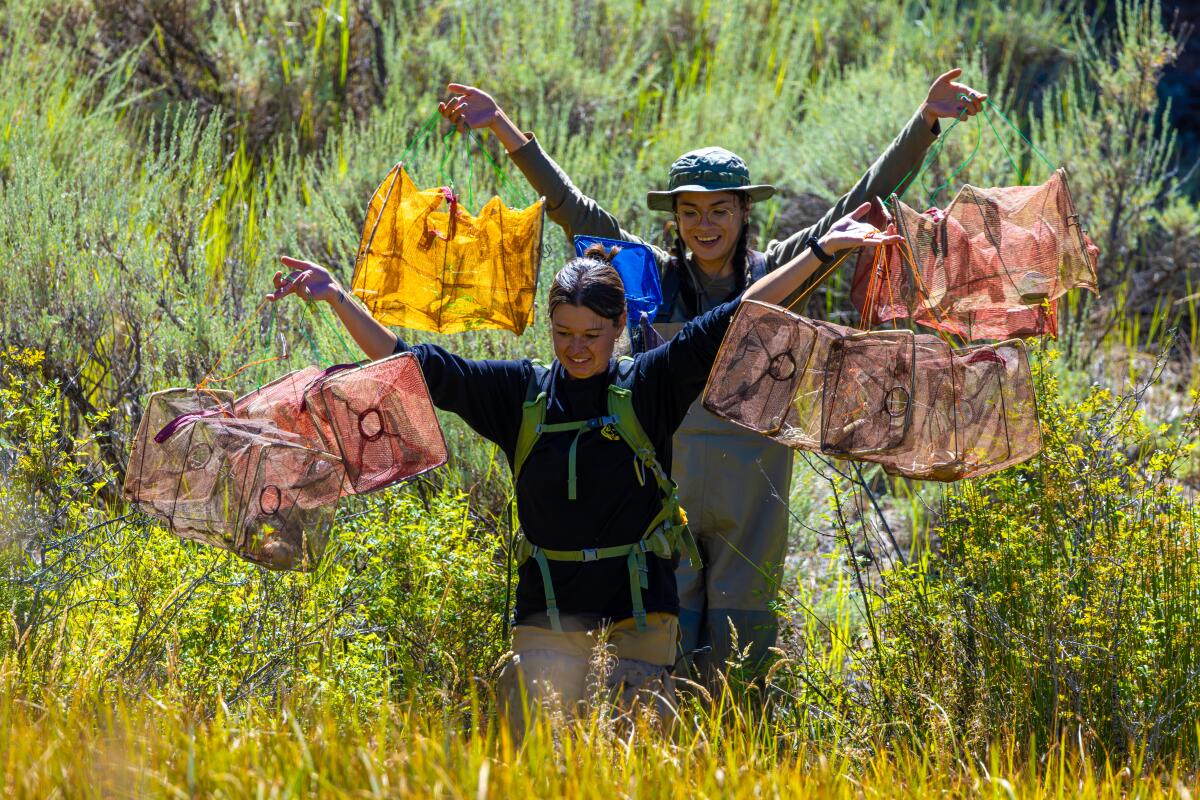
Earlier this month, Krantz visited a stickleback translocation effort that he helped to organize.
A team of state and federal biologists clad in waders and armed with long-handled nets and fish traps baited with blue cheese moved sticklebacks from an alpine pond to “burro-free” Bluff Lake, which is privately owned by The Wildlands Conservancy, about 10 miles away.
The 200 sticklebacks transported to Bluff Lake joined 74 captive-bred endangered Southern California yellow-legged frogs released there in June as part of an effort to “re-wild” historic haunts where the species have not been seen — or heard — in more than seven decades.
“This project has been a long time coming,” Krantz said with a smile. “A year from now, these reintroduced sticklebacks and yellow-legged frogs are going to be the kings of beasts at Bluff Lake.”
- Share via
Watch L.A. Times Today at 7 p.m. on Spectrum News 1 on Channel 1 or live stream on the Spectrum News App. Palos Verdes Peninsula and Orange County viewers can watch on Cox Systems on channel 99.
